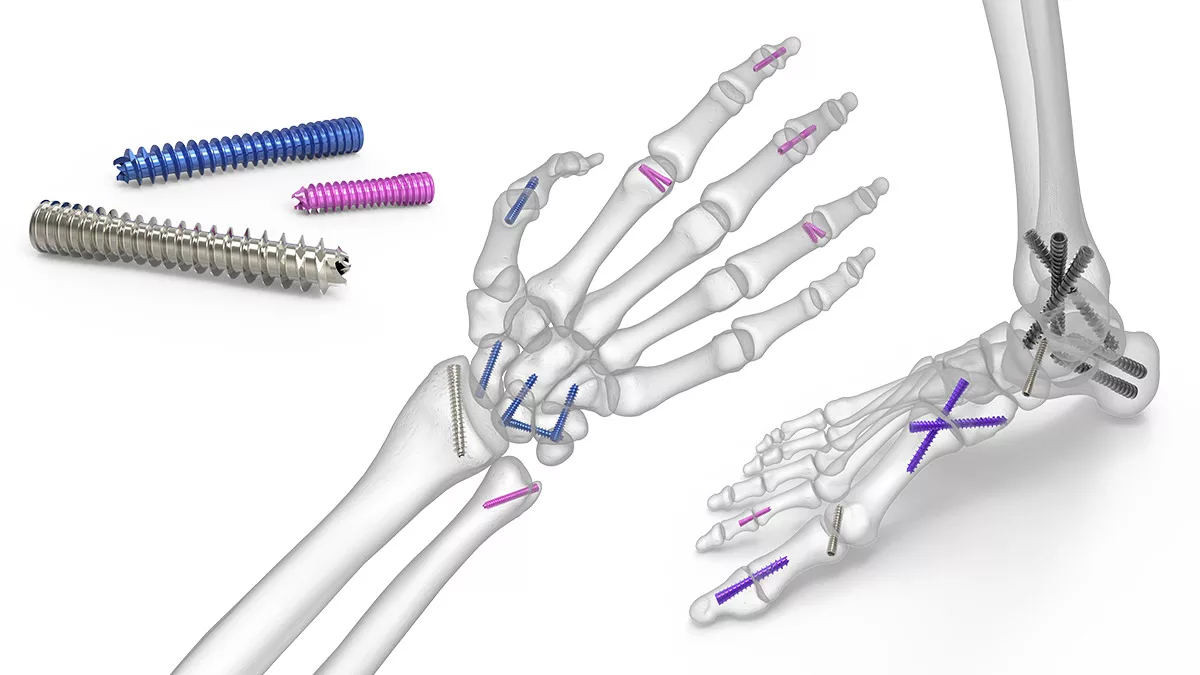 Orthopedic implants known as headless screws, cannulated headless screws, or Headless Herbert screws are used to repair broken bones and perform osteotomies in specific cases. They are called “headless” screws because they lack a conventional screw head and have a completely threaded design.
Orthopedic implants known as headless screws, cannulated headless screws, or Headless Herbert screws are used to repair broken bones and perform osteotomies in specific cases. They are called “headless” screws because they lack a conventional screw head and have a completely threaded design.
Introduction
The Headless Herbert Screw – invented by Timothy Herbert, is a biocompatible titanium screw with a variable pitch intended to reside permanently in the patient’s body. It became widely accessible in 1978.
This is one of the earliest designs of headless compression screws, used to accomplish inter-piece compression by utilizing the difference in pitch (distance between adjacent threads) between the threads on both ends of the screw. They are used for fractures of the scaphoid, capitellum, radial head, and osteochondral tissue. In addition, osteochondritis dissecans and facet arthrodesis are also used.
Understanding Orthopedic Screws
For fractured bones to recover rapidly, there must be a minimal amount of space between the fractured pieces. Orthopedic fixation is primarily reliant on orthopedic fasteners, as they facilitate bone healing by compressing fractured bones together while minimizing undue strain on orthopedic implants.
Individually or in conjunction with other orthopedic devices, such as plates, these fasteners may be used during surgery.
These two are the most common varieties of orthopedic screws, but many others exist.
-> The cortical
-> Cancellous screws
Introducing the Headless Herbert Screw
Headless Herbert Orthopedic Screws are usually cylindrical and contain titanium or stainless steel. They have a porous core or cannulation that permits the insertion of a guide wire during surgery.
The Headless Compression Screw design facilitates precise screw placement and can aid in the compression and fixation of bone fragments.
Headless screws are different because they don’t have a visible screw head. They have a uniform surface that is aligned with the bone when they are entirely inserted.
This feature from Herbert Screw System reduces the likelihood of soft tissue irritation and permits a more anatomical fit.
When it is desired to minimize prominence or when a conventional screw head would interfere with adjacent structures, headless screws are frequently employed.
Mechanism of Action
A headless compression screw is a cannulated screw with a design lacking a head. This form of orthopedic screw is utilized to fix minor bone fractures, nonunions, and arthrodesis.
These fasteners have cortical threads on one end and cancellous threads on the other, with an unthreaded smooth section in between.
These headless compression screws’ proximal threads are designed to generate compression between bones and provide the necessary stability for a fracture to heal.
Applications in Orthopedic Surgery
Because the Headless Herbert Orthopedic Screw does not have any protrusions, it causes little tissue irritation when implanted into a bone. Cannulation permits the precise placement of screws on bone in locations with minimal tissue coverage.
Surgical Technique
To insert a headless Herbert screw, a surgeon must be accurate and plan carefully. Before the surgery, imaging studies are carried out to determine the best size and placement of the screws. During surgery, the screw is put in through a small cut, and a cannulated method is used to guide it.
The surgeon carefully sets up the pieces of bone and presses them with the headless screw. The pressure that is applied helps keep the bones stable and helps them heal properly. After surgery, patients go through a time of recovery and close monitoring to ensure things go well.
Clinical Results and Patient Outcomes
In orthopedic surgery, using Headless Herbert Screw has shown positive results in clinical tests.
These screws’ capacity to apply compression results in better fracture reduction and increased stability. This, in turn, helps patients get better and heal faster.
When compared to traditional fixing methods, patients who have surgery with headless Herbert screws often feel less pain, recover more quickly, and have better joint function.
The success of these screws lies in their ability to align the body and fix it safely while causing little pain to the soft tissues.
Limitations and Future Developments
Although headless Herbert screws have demonstrated high success in various orthopedic operations, there are certain restrictions to keep in mind.
It can be hard to find screws that are the right size and shape for different bone types and injury structures.
Long-term results and problems from these screws need to be studied more thoroughly. But as materials, designs, and techniques in medicine keep getting better, these problems are being fixed, giving orthopedic surgery more options.
Implanting headless Herbert screws demands surgical accuracy. Surgeons must be trained to implant and compress screws without injuring surrounding tissues or structures.
Headless Herbert Orthopedic Screw may cost more than typical fixing processes. Healthcare providers and patients value affordability and cost-effectiveness.
Wrapping It Up
The Headless Herbert Orthopedic Screw, which lacks a traditional head, has changed orthopedic surgery, allowing for more accuracy and better patient results. The use of this innovative technology by orthopedic surgeons will enable them to provide their patients with improved fixation, quicker recovery, and a more anatomical fit. Orthopedic operations will continue to progress to improve patient care and quality of life as a result of continuous innovations and research.

